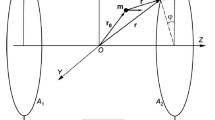Abstract
A generalized structural diagram is given for an intelligent magnetostrictive displacement transducer (MDT) that converts displacement into code. A logometric mathematical model is constructed for the random error distribution in the MDT, with a normal distribution for the independent random errors of the measuring and reference channels.
Similar content being viewed by others
References
V. G. Domrachev, V. R. Matveevskii, and Yu. S. Smirnov, Circuit Engineering of Digital Displacement Transducers. A Handbook [in Russian], Énergoatomizdat, Moscow (1987).
A. I. Nadeev, Magnetostrictive Intelligent Parameters-of-Motion Transducers [in Russian], Astrakhan State Technical University, Astrakhan' (1999), Dep. No. 2385- V99, VNITI (Institute of Scientific and Technical Information), July 22, 1999.
B. V. Gnedenko, Probability Theory Course, [in Russian], Nauka, Moscow (1988).
A. I. Nadeev et al., in: V. N. Azarov (ed.), “Sensors and Information Converters for Measuring, Monitoring, and Control Systems (Datchik-98),” MGIÉ ( Moscow State Institute of Electronics and Mathematics), Moscow (1998).
P. V. Novitskii and I. A. Zograf, Estimation of the Errors of Measurements [in Russian], Énergoatomizdat, Moscow (1991).
A. I. Nadeev, Izmer. Tekh., No. 12, 13 (1991).
Rights and permissions
About this article
Cite this article
Nadeev, A.I., Sevost'yanova, E.V. & Vdovin, A.Y. Mathematical Model of the Error of a Magnetostrictive Displacement Transducer. Measurement Techniques 44, 37–43 (2001). https://doi.org/10.1023/A:1010916729253
Issue Date:
DOI: https://doi.org/10.1023/A:1010916729253




